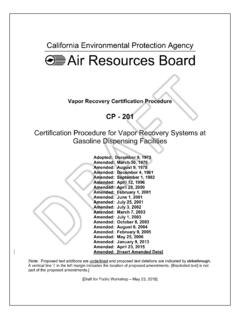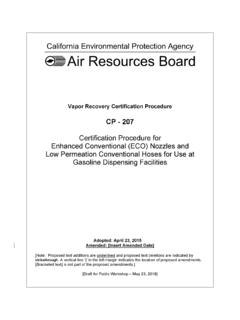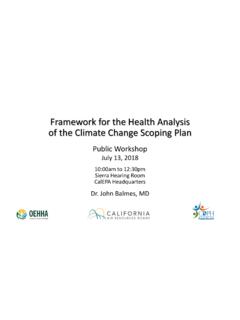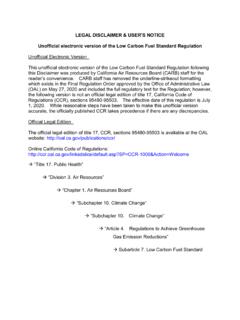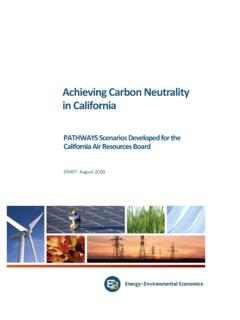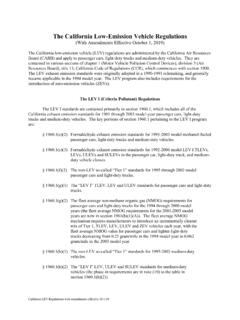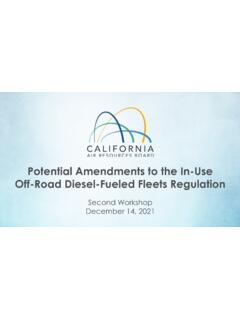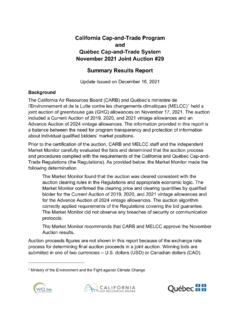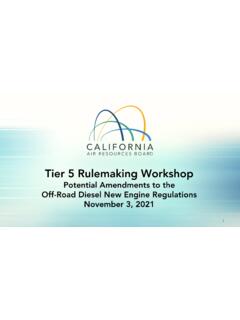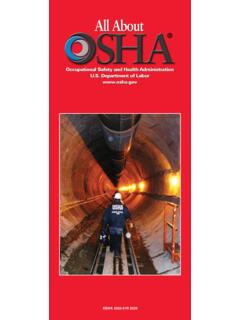Transcription of LCFS Basics with Notes - California Air Resources Board
1 1 2 In 2009 the Board approved the LCFS regulation to reduce the carbon intensity (CI) of transportation fuel used in California by at least 10 percent by 2020 from a 2010 baseline. In 2011, the Board approved amendments to clarify, streamline, and enhance certain provisions of the regulation. In 2015, the Board re adopted the LCFS to address procedural issues, which began implementation on January 1, 2016.
2 In 2018, the Board approved amendments to the regulation, which includes strengthening and smoothing the CI benchmarks through 2030 in line with California s 2030 GHG target enacted through SB32. The LCFS is one of the key AB 32 measures to reduce greenhouse gas emissions in California but also has other significant benefits. It transforms and diversifies the fuel pool in California to reduce petroleum dependency and achieves air quality benefits, which are State priorities that preceded AB 32. 3 The LCFS is designed to reduce GHG emissions in the transportation sector, which is responsible for about 50 percent of GHG emissions (including industrial sector emissions from refining and crude production), 80 percent of ozone forming gas emissions, and over 95 percent of diesel particulate matter.
3 It is a key part of a comprehensive set of programs in California to reduce emissions from the transportation sector, including the Cap and Trade Program, Advanced Clean Cars Program, and SB 375. 4 The LCFS sets annual carbon intensity (CI) standards, or benchmarks, which reduce over time, for gasoline, diesel, and the fuels that replace them. Carbon intensity is expressed in grams of carbon dioxide equivalent per megajoule of energy provided by that fuel. CI takes into account the GHG emissions associated with all of the steps of producing, transporting, and consuming a fuel also known as a complete life cycle of that fuel.
4 The LCFS lets the market determine which mix of fuels will be used to reach the program targets. 5 Fuels and fuel blendstocks introduced into the California fuel system that have a CI higher than the benchmark generate deficits. Similarly, fuels and fuel blendstocks with CIs below the benchmark generate credits. Annual compliance is achieved when a regulated party uses credits to match its deficits.
5 Since the regulation was first adopted, the compliance curves have been back loaded to allow time for the development of low CI fuels and advanced vehicles (the benchmark CI reduction was frozen by court order for three years between 2013 and 2015). Due to this program design choice, there has always been the expectation that excess credits generated in the early years of the program would be available for use in more stringent future years, if needed. Under the current LCFS regulation, the 2030 standard of a 20 percent CI decline will also be imposed for all years post 2030. 6 7 Since the regulation went into effect, low carbon fuel use has increased.
6 Fuel producers are also taking action to decrease the carbon intensity of their fuels. The program has an established market for credit transactions. The total value of credit transactions exceeded $2 billion in 2018. The LCFS Data Dashboard web page was created to display the current and historical LCFS program data. Some of the information found in the Data Dashboard are the following: Volume of fuels and credits generated under the LCFS Compliance curve and the percent reduction in carbon intensity to date Credit volumes transacted and the average credit prices per month under the LCFS. To see the Data Dashboard, please see 8 Other jurisdictions are joining California , which is evident in the Pacific Coast Collaborative, a regional agreement between California , Oregon, Washington, and British Columbia to strategically align policies to reduce greenhouse gases and promote clean energy.
7 One of the provisions of this Collaborative explicitly addresses Low Carbon Fuel Standard programs. California , Oregon, and British Columbia have existing LCFS programs in place and the Washington legislature is considering a program. Staff has been routinely working with these jurisdictions, providing assistance where we can. Over time, these LCFS programs will build an integrated West Coast market for low carbon fuels that will create greater market pull, increased confidence for investors of low carbon alternative fuels, and synergistic implementation and enforcement programs. Other regions including Canada and Brazil are also noticing California s success and developing LCFS like performance standards for transportation fuels.
8 9 10 There are three ways to generate credits in the LCFS: fuel pathways, projects, and capacity based crediting. Under fuel pathway based crediting, all transportation fuels need a carbon intensity score to participate in the LCFS, and the fuel type dictates which process is used to determine that CI.
9 Providers of low carbon fuels used in California transportation generate credits by obtaining a certified CI and reporting transaction quantities on a quarterly basis. Credits are calculated relative to the annual CI benchmark and will undergo verification post credit generation. Under project based crediting, projects include actions to reduce GHG emissions in the petroleum supply chain, and also CCS using direct Air Capture. Crediting for projects is based on life cycle emission reductions, and credits are issued after the reported reductions are verified. Finally, the 2018 amendments added a new crediting mechanism to the LCFS which is designed to support the deployment of zero emission vehicle infrastructure.
10 Crediting for ZEV infrastructure is based on the capacity of the hydrogen station or EV fast charging site minus the actual fuel dispensed. 11
